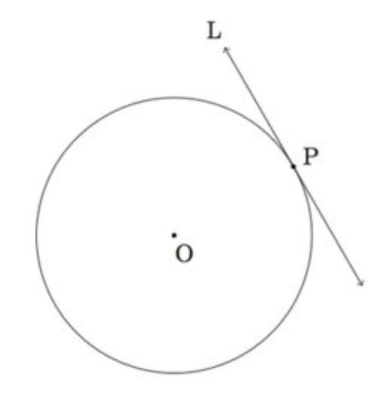
What do you say about the line which is perpendicular to the radius of the circle through the point at circumference?
Answer
506.4k+ views
Hint: The incredible number and variety of circumstances in science where circles are used to model physical phenomena reflects their theoretical significance. Theorems of circle geometry are not intuitively apparent to students; in fact, most people are shocked when they first see the results.
Complete step-by-step answer:
Tangent to the circle is a line that is perpendicular to the radius of the circle and passes through the point at the circumference. Actually it is said to be a tangent is a straight line drawn from an external point that touches the circumference of a circle at exactly one point. So it is commonly said that a circle can have an infinite number of tangents. These tangents have certain properties that can be used to perform mathematical computations on circles using identities.
So actually it is said to be a tangent to a circle is a line that only intersects the circle once. It is possible that the line is a secant, splitting the circle in two places. The line could be a tangent, just touching the circle once. It is possible that the line would completely skip the circle.
A point of contact is the point where a tangent meets a circle. It is not immediately clear how to draw a tangent at a specific point on a circle, or even whether there are several tangents at that point.
A circle's radius is perpendicular to the tangent line passing through its endpoint on the circumference. A tangent line, on the other hand, is the perpendicular to a radius passing through the same endpoint. The geometrical figure of a circle and tangent line that results has reflection symmetry around the radius axis.

So, the correct answer is “TANGENT”.
Note: The terms ‘secant' and 'tangent' are both Latin words that mean 'cutting' (as in 'cross-section') and 'touching' (as in 'tango'). The graph of the affine function that best approximates the original function at the given point can also be thought of as the tangent line to a point on a differentiable curve.
Complete step-by-step answer:
Tangent to the circle is a line that is perpendicular to the radius of the circle and passes through the point at the circumference. Actually it is said to be a tangent is a straight line drawn from an external point that touches the circumference of a circle at exactly one point. So it is commonly said that a circle can have an infinite number of tangents. These tangents have certain properties that can be used to perform mathematical computations on circles using identities.
So actually it is said to be a tangent to a circle is a line that only intersects the circle once. It is possible that the line is a secant, splitting the circle in two places. The line could be a tangent, just touching the circle once. It is possible that the line would completely skip the circle.
A point of contact is the point where a tangent meets a circle. It is not immediately clear how to draw a tangent at a specific point on a circle, or even whether there are several tangents at that point.
A circle's radius is perpendicular to the tangent line passing through its endpoint on the circumference. A tangent line, on the other hand, is the perpendicular to a radius passing through the same endpoint. The geometrical figure of a circle and tangent line that results has reflection symmetry around the radius axis.

So, the correct answer is “TANGENT”.
Note: The terms ‘secant' and 'tangent' are both Latin words that mean 'cutting' (as in 'cross-section') and 'touching' (as in 'tango'). The graph of the affine function that best approximates the original function at the given point can also be thought of as the tangent line to a point on a differentiable curve.
Recently Updated Pages
Master Class 8 Social Science: Engaging Questions & Answers for Success

Master Class 8 Maths: Engaging Questions & Answers for Success

Master Class 8 Science: Engaging Questions & Answers for Success

Class 8 Question and Answer - Your Ultimate Solutions Guide

Master Class 8 English: Engaging Questions & Answers for Success

Why are manures considered better than fertilizers class 11 biology CBSE

Trending doubts
What is BLO What is the full form of BLO class 8 social science CBSE

Citizens of India can vote at the age of A 18 years class 8 social science CBSE

Full form of STD, ISD and PCO

Right to vote is a AFundamental Right BFundamental class 8 social science CBSE

What is the difference between rai and mustard see class 8 biology CBSE

Summary of the poem Where the Mind is Without Fear class 8 english CBSE





